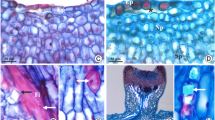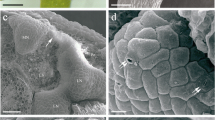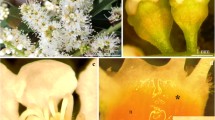Abstract
The cowpea bears two distinctive types of extrafloral nectaries. One, on the stipels of trifoliolate leaves, consists of a loosely demarcated abaxial area (1–2 mm diameter) of widely-spaced trichomes (papillae) borne on a stomata-free epidermis, and lacking a specific vascular supply. Each trichome has up to eight apical (head) cells, two to four intermediate cells, and a single large stalk cell. The secretory faces of the apical cells bear wall ingrowths and an easily detached cuticle. The wall separating the stalk cell and the underlying epidermal cell(s) has a mean plamodesmatal frequency of 25/μm2. The second type of nectary consists of a large elliptical mound of tissue (short and long axes about 2 mm and 4 mm) formed between a pair of flowers on an inflorescence stalk. It comprises four to eight cone-shaped subnits of secretory tissue, each with a circular secretory orifice and an individual supply of phloem, but not of xylem. Cells of the secretory tissue of the nectary subunits separate as they mature, and nectar flows to the orifice through the resulting intercellular spaces. Intact secretory cells and cellular debris are extruded into the nectar. Some of the sieve elements terminating in the inner secretory tissue exhibit open sieve pores. Each mature secretory cell contains many small (2 μm diameter) spherical protein bodies and one to three large (up to 2–3 μm diameter 15 μm long), paracrystalline bodies. These inclusions are absent or not fully developed in inner, less mature regions of the secretory tissue. Mechanisms of secretion are proposed for the two classes of nectary, including estimates of flux of sugar into the trichomes of the stipel nectary.
Similar content being viewed by others
References
Baker, D.A., Hall, J.L., Thorpe, J.R. (1978) A study of the extrafloral nectaries of Ricinus communis. New Phytol. 81, 129–137
Benner, U., Schnepf, E. (1975) Die Morphologie der Nektarausscheidung bei Bromeliaceen: Beteiligung des Golgi-Apparates. Protoplasma 85, 337–349
Boughton, V.H. (1981) Extrafloral nectaries of some Australian phyllodineous acacias. Aust. J. Bot. 29, 653–664
Boughton, V.H. (1985) Extrafloral nectaries of some Australian bipinnate acacias. Aust. J. Bot. 33, in press
Cristobal, C.L., Arbo, M. M. (1971) Sobre las especies de Ayenia (Sterculiaceae) con nectarios foliares. Darwinia 16, 603–612
Currier, H.B., Strugger, S. (1956) Aniline blue and flourescence microscopy of callose in bulb scales of Allium cepa L. Protoplasma 45, 552–559
Durkee, L.T., (1982) The floral and extrafloral nectaries of Passiflora. II. The extrafloral nectary. Am. J. Bot. 69, 1420–1428
Eleftheriou, E.P., Hall, J.L. (1983) The extrafloral nectaries of cotton. 1. Fine structure of the secretory papillae. J. Exp. Bot. 34, 103–119
Elias, T.S. (1972) Morphology and anatomy of foliar nectaries of Pithecellobium macradenium (Leguminosae). Bot. Gaz. 133, 38–42
Elias, T.S., Gelband, H. (1976) Morphology and anatomy of floral and extrafloral nectaries in Campsis (Bignoniaceae). Am. J. Bot. 63, 1349–1353
Elias, T.S., Rozich, W.R., Newcombe, L. (1975) The foliar and floral nectaries of Turnera ulmifolia L. Am. J. Bot. 62, 570–576
Eymé, J. (1966) Infrastructure des cellules nectarigènes de Diplotaxis eurcoides D.C., Helleborus niger L., et. Helleborus foetidus L. C.R. Acad. Sci. 262, 1629–1632
Fahn, A. (1979) Secretory tissues in plants, pp. 51–111. Academic Press, London New York
Fahn, A., Rachmilevitz, T. (1970) Ultrastructure and nectar secretion in Lonicera japonica. Bot. J. Linn. Soc. 63, Suppl. 1, 51–56
Figier, J. (1971) Fine structure in the extrafloral nectary of Vicia faba L. Planta 98, 31–49
Findlay, N., Mercer, F.V. (1971) Nectar production in Abutilon. II. Submicroscopic structure of the nectary. Aust. J. Biol. Sci. 24, 657–664
Frey-Wyssling, A. (1955) The phloem supply to the nectaries. Acta. Bot. Neerl. 4, 358–369
Grout, B.W.W., Williams, A. (1980) Extrafloral nectaries of Dioscorea rotundata Poir: Their structure and secretions. Ann. Bot. 46, 255–258
Gunning, B.E.S., Hughes, J.E. (1976) Quantitative assessment of symplastic transport of pre-nectar into the trichomes of Abutilon nectaries. Aust. J. Plant Physiol. 3, 619–637
Gunning, B.E.S., Pate, J.S. (1974) Transfer cells. In: Dynamic aspects of plant ultrastructure, pp. 441–480, Robards, A.W., ed. McGraw Hill, Maidenhill, England
Lüttge, U. (1977) Nectar composition and membrane transport of sugars and amino acids. Apidologie 8, 305–319
Pate, J.S., Peoples, M.B., Atkins, C.A. (1983) Post-anthesis economy of carbon in a cultivar of cowpea. J. Exp. Bot. 34, 544–562
Pate, J.S., Peoples, M.B., Storer, P.J., Atkins, C.A. (1985) The extrafloral nectaries of cowpea (Vigna unguiculata (L.). Walp): II. Nectar composition, origin of nectar solutes and nectary functioning. Planta 166, 28–38
Schnepf, E. (1964) Zur Cytologie und Physiologie pflanzlicher Drüsen. 4. Licht- und elektronenmikroskopische Untersuchungen an Septalnektarien. Protoplasma 58, 137–171
Spurr, A.R. (1969) A low viscosity epoxy resin embedding medium for electron microscopy. J. Ultrastruct. Res. 26, 31–43
Wergin, W.P., Elmore, C.D., Hanny, B.W. and Ingber, B.F., (1975) Ultrastructure of the subglandular cells from the foliar nectaries of cotton in relation to the distribution of plasmodesmata and the symplastic transport of nectar. Am. J. Bot. 62, 842–849
Wrischer, M. (1962) Electronic microscope examination of the floral nectaries of Vicia faba. Acta. Bot. Croat. 20/21, 75–94
Zimmermann, J.G., (1932) Über die extrafloralen Nektarien der Angiospermen. Bot. Zentralbl. A 49, 99–196
Author information
Authors and Affiliations
Rights and permissions
About this article
Cite this article
Kuo, J., Pate, J.S. The extrafloral nectaries of cowpea (Vigna unguiculata (L.) Walp): I. Morphology, anatomy and fine structure. Planta 166, 15–27 (1985). https://doi.org/10.1007/BF00397381
Received:
Accepted:
Issue Date:
DOI: https://doi.org/10.1007/BF00397381




